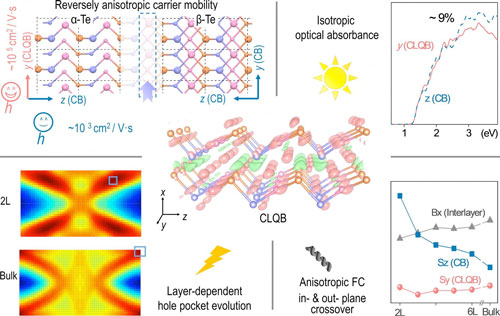| Posted: Feb 09, 2018 |
Few-layer tellurium as a promising successor of black phosphorus
(Nanowerk News) Two-dimensional (2D) layered materials have received considerable attention because of their potential applications in various fields since the experimental discovery of graphene.
|
|
Two-dimensional elementary semiconductors are particularly desired owing to their superior features in terms of fabrication, purification and doping.
|
|
Few-layer black phosphorus (BP) is the first 2D mono-elementary semiconductor showing high electronic carrier mobility, strong optical absorption, linear dichroism, promising figure of merit and high tunability with external fields. All the properties immediately put few-layer BP under spotlights since its discovery in 2014.
|
|
However, the flawed air-stability and difficulties in largescale fabrication were found to be two remaining issues that obscure practical applications of few-layer BP in the industry. People thus get started to question if a promising or even superior successor of BP exists. The target semiconductor is preferably an elementary one. It should also allow low-cost and large-scale synthesis and offer good environmental stability without sacrificing those striking properties offered by BP.
|
|
Professor Wei Ji has led a research group at Renmin University of China to theoretically model surfaces and interfaces of emerging electronic materials and to predict physical properties of devices comprised of these materials.
|
|
Recently, they collaborated with Prof. Yang Chai from the Hong Kong Polytechnic University to report a theoretical study of a novel chain-like 2D-material, namely few-layer α-Tellurium (FL-α-Te), and predicted this material to have extremely high carrier mobility with a layer-tunable bandgap, strong light absorption, mixing of vibrational modes, layer-dependent energy maps of valence and conduction bands and among other striking properties ("Few-layer Tellurium: one-dimensional-like layered elementary semiconductor with striking physical properties").
|
 |
| A chain-like two-dimensional material, few-layer alpha-Tellurium, has intrinsically geometric anisotropy, anisotropic inter-chain (-layer) vibrational behaviors, higher mobility along the non-covalent bonding direction and isotropic light absorption, as governed by the found covalent-like quasi-bonding for the inter-chain (-layer) interactions. (© Science China Press) (click on image to enlarge)
|
|
The FL-α-Te is a representative material of layered one-dimensional materials, which are a novel and fast developing category of 2D-materials. They first examined the stability of three likely few-layer phases using state-of-the-art density functional theory calculations.
|
|
Their calculation shows α-Tellurium is the most stable phase for bilayer and thicker layers. Given the stability unveiled, they found that a covalent-like quasi-bonding (CLQB) dominates the inter-chain interaction in both intra- and inter-layer directions. This CLQB is in analogy to the found interlayer interactions in BP, PtS2 or PtSe2, in which it shows wavefunction hybridization but does not provide extra energy gain.
|
|
They managed to correlate this bonding with the layer-dependent geometric and electronic structures and their resulting behaviors in terms of electric, optical, and vibrational properties.
|
|
Few-layer α-Te has extremely high hole-mobility up 105 cm2/Vs exceptionally along the non-covalent-bound (CLQB) direction and 103 cm2/Vs for the covalent-bound direction, tunable bandgap from 0.31 eV (Bulk) to 1.17 eV (2L), anisotropic inter-chain (-layer) vibrational behaviors, a crossover of interlayer shear and breathing force constants, large ideal strength (over 20%) and nearly isotropic strong light absorption (up to 9% per layer) from a highly anisotropic geometry.
|
|
They also found, specifically in few-layer α-Te, that the energy surfaces of both valence and conduction bands substantially develop from bulk to bilayer, exhibiting an ``M-like" line profile of the hole pocket, which was usually found in topological insulators and is ideal for thermoelectrics.
|
|
This material succeeds most of the striking properties of BP and additionally offers a better environmental stability, a much lower fabrication cost (with wet-chemistry methods) and a stronger light absorption than those of BP. In this scenario, FL-α-Te could be regarded as a superior successor of BP.
|
|
The extraordinarily high carrier mobility revealed in the CLQB direction conceptually updates the understanding of the role of non-covalent interactions in carrier mobility and may open a new avenue for seeking high carrier mobility materials.
|

